Bell Peppers: Differences and How to Cook Them
This page contains affiliate links. For more information please read my Disclosure Policy.
In this Complete Cooking Guide discover fun facts about all the colors of bell peppers and get ideas for cooking each type to maximize their flavor
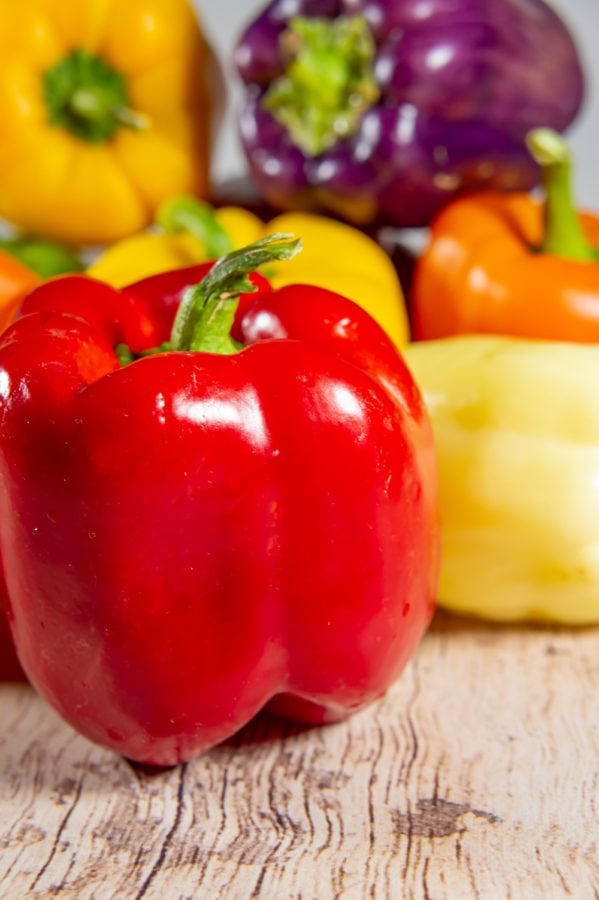
Have you noticed how gorgeous bell peppers are around this time of year? Grocery stores and farmers markets are full of their vibrant colors.
Here you’ll find everything you could need to know about the differences in bell peppers plus suggestions on how to cook them and fun delicious recipes to help inspire you! Are you excited yet?
What are Bell Peppers?
Peppers and chilies are both a part of the capsicum family, and come in a seriously huge variety ranging in size, flavor, and spice.
Bell peppers are a sweet pepper, only ranging to the high 500’s in Scoville units (jalapenos are between 2500 and 10000). They’re distinguished from their other sweet cousins and the spicier chilies by the typical bell shape that you are all familiar with. They’re also botanically classified as a fruit – not a vegetable.
But not all bell peppers come in that shape. A good example is the La Rogue Royale pepper – a longer, slimmer version of a red bell pepper.
I’d also like to note that there is no such thing as male and female bell peppers, three bumps versus four simply implies a different variety of the plant. And, it’s not the shape or size that determines flavor.
Number of bumps, short or long, thin or fat, flavor is determined by the varietal and the color of the final fruit.
Differences in Bell Peppers
Now let’s dive into what the differences are in the most common bell peppers that we’re all eating during the summer months.
Sweetness by Color
Since color determines flavor, and more so, sweetness, it’s pretty important to know what you’re looking for before you pick a nice green or orange bell pepper. What you prefer can be a personal preference, but here are a few tips on the different colors.
Red, orange, & Yellow Bell Peppers
These are your common color choices this time of year at any grocery store. They’re often more expensive than green ones, and with good reason. Red, orange, and yellow bell peppers are the sweetest varieties, going from sweetest to less sweet in that order.
My personal favorites are red and orange, but any of the three will work when you’re looking for a sweetness in your recipe. They all take well to most preparation methods from roasting to raw.
Purple, White, and Green Bell Peppers
Once you pass yellow and fade into cooler colors, the sweetness fades as well. Green, white, and purple bell peppers aren’t as sweet as the other colors.
Instead they have a grassy, fresh flavor profile that has a pleasant bite of crisp bitterness. Green is the least so, while purple has a noticeable bitter bite.
While these again can be used for most bell pepper applications, it’s going to make a difference if you substitute green when a red pepper is called for.
There are certain recipes that were made for the crisp bite. These varieties are perfect for stuffing, pickling, or pairing with sweet glazed proteins. They’re also great raw in a slaw or salad, especially purple bell peppers which tend to loose their color when cooked.
Having trouble finding white and purple bell peppers? It’s often the farmers market where I find the less commercially popular colors like those.
From Green to Red…
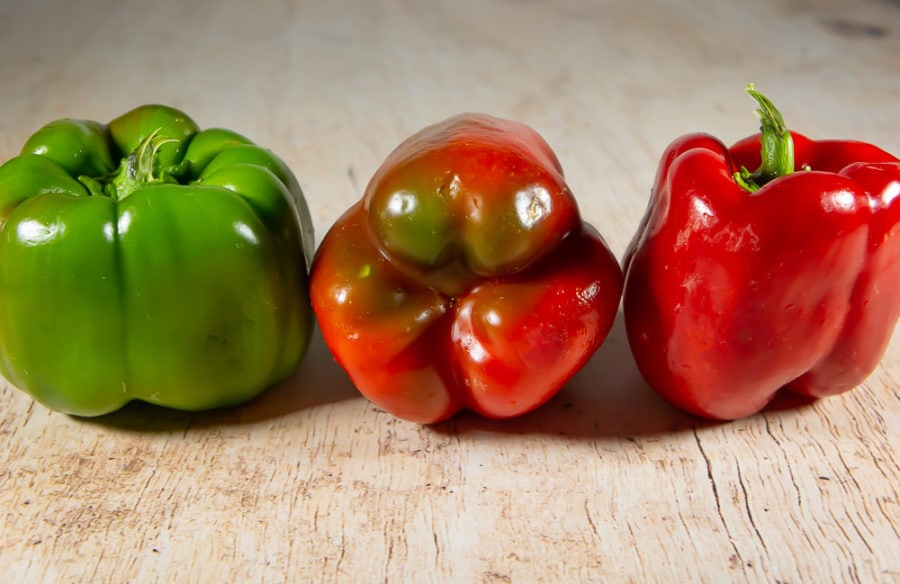
As a quick aside, have you ever noticed that green bell peppers always seem to be in abundance? There’s a reason! They’re actually red peppers that aren’t fully ripe.
No way, right?! It’s true! Green peppers have been picked before they’ve reached full maturity, one reason for their more bitter flavor, the sweetness simply hasn’t developed fully.
It also makes them cheaper. Without such a long growing time farmers and producers can supply them easier.
Yellow and orange peppers are not unripe red peppers. They’re different varieties of bell pepper. All peppers start out as green however, including those jalapenos we all know and love…yup they’d turn red!
The Health Benefits of Bell Pepper
Beyond the flavor, there are some added health benefits to eating the sweet bell peppers – tons of vitamins. They’re high in vitamin C, like really high, and full of other vitamins and nutrients like E, B6, K1, potassium, folate, iron, and in red bell peppers Vitamin A.
Allowing the fruit to ripen increases the nutrient levels when consumed, so in addition to a sweeter flavor, picking red over green bell peppers is going to increase the health benefits you receive.
How & When to Pick Bell Peppers
Bell peppers are available year around nowadays, green bells especially, but the peak season for the best flavor is July through September.
When picking your pepper, be sure to look for a glossy, smooth exterior and a green stem. Avoid the wrinkles or brown spots. They should be firm to the touch, with no damp or soft areas. Store them in the bottom of your fridge and they’ll keep for a few days.
How to Cook bell peppers – 6 methods
You’ve decided the colors you love, next is how to cook bell peppers. It’s a tough decision! Whether you want to learn how to roast bell peppers for a creamy soup, or you want to do a quick chop for a simple summer salad, there are over a dozen delicious bell pepper recipes below organized by how you cook them.
Pro Tip: To reduce the bitterness of ANY color bell pepper, use a vegetable peeler to remove as much skin as possible before cooking or eating raw.
1. RAW
This is one of my favorite ways to eat them. They’re an excellent addition to salads, spring rolls, coleslaw or just to snack on plain with a fresh dip.
When I prep them for raw use, my usual method is to hold the pepper stem up, and slice from top to bottom on each side, making 4 cuts. This will avoid most of the seeds and result in 4 flat slices of pepper.
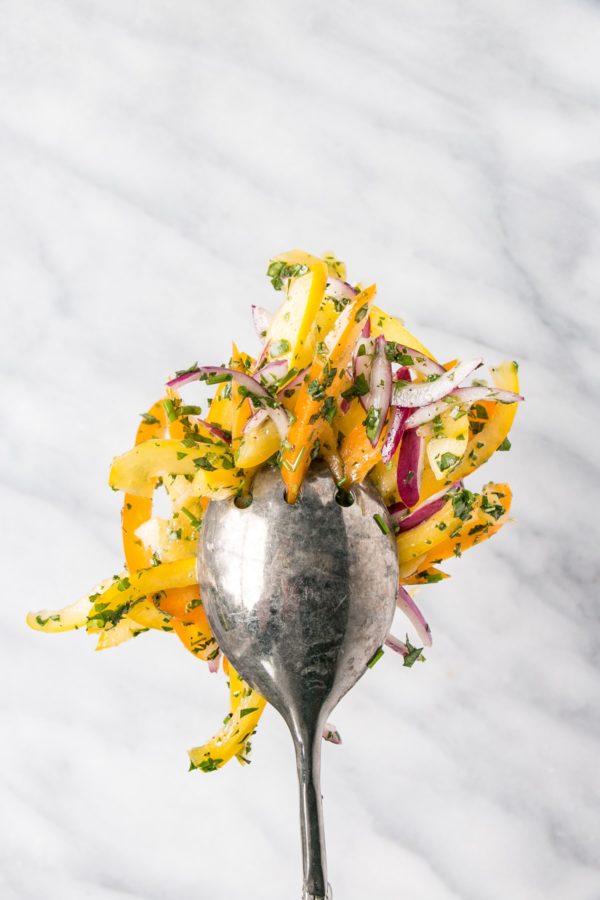
To inspire your raw bell pepper cooking, here are two delicious recipes that feature uncooked bell peppers:
- Herby Sweet Pepper and Onion Salad (pictured above) from My Kitchen Love – this is a simple but gorgeous salad to really highlight those sweet pepper flavors!
- Green Pepper Salad with Tomatoes from Veggies Save the Day – Tomatoes, olives, and green bell peppers are a big bowl of flavor in this fresh salad. Yum!
2. ROASTED
This may be the most well known form of cooking sweet red peppers. Roasted red peppers are delicious, no arguments there, but you can also roast the many other colors too! I encourage you to try them out as well.
You could purchase pre-roasted peppers, but it’s actually easy to do yourself with a few simple steps. Check out my How To Roast Peppers guide for step by step instructions.
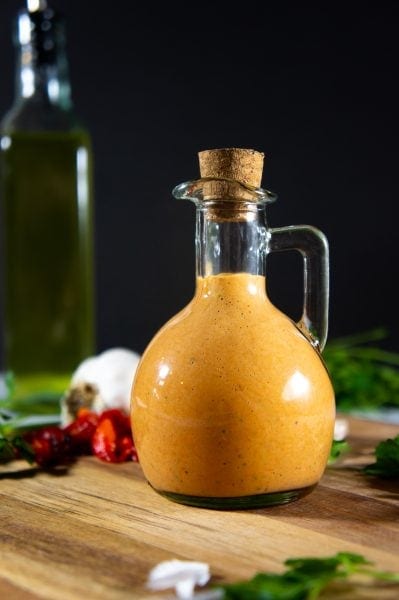
They can be used in a myriad of ways. Puree them in a sauce, marinade, aioli, or veggie dip. Serve them sliced on sandwiches, pastas, and more. The uses are as endless as your creativity!
- Red Pepper Aioli (pictured above) from here at The Flour Handprint – A homemade mayo infused with delicious roasted red pepper sweetness. It’s the sandwich spread of your dreams.
- Muhammara Roasted Red Peppers and Walnut Dip from Unicorns in the Kitchen – This simple to make dip is an incredibly flavorful variation to other dips like hummus.
- Avocado Corn Salad with Roasted Red Peppers from right here at The Flour Handprint – A light salad of roasted corn and roasted red peppers with creamy avocado and lime.
- Roasted Red Pepper and Tomato Soup from Hungry Happy Healthy – Simple gorgeous ingredients come together in a vibrant red pepper soup you’ll love.
3. SAUTEED
This is likely one of the most common ways to utilize bell peppers. With a few simple knife cuts you can add color and freshness into many different dishes. Here are just a few of MANY suggestions:
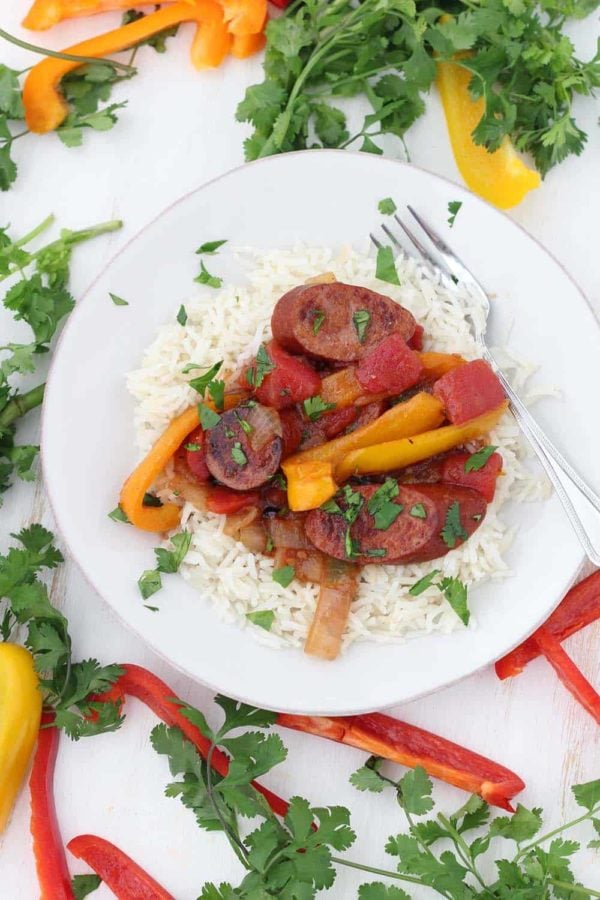
- Sauteed Bell Pepper Salad from Babaganosh – Nothing like appreciating the beauty of peppers than a salad that features them as the primary ingredient. This is a winner!
- Sweet and Spicy Sausage with Peppers and Onions from Bowl of Delicious (pictured above) – Sweet, smoky, spicy this quick and easy dinner has it all, sweet fresh bell peppers included!
- Crispy Chicken Sandwiches from here at The Flour Handprint – One of the big flavors that makes this sandwich special is the sauté of orange bell pepper and onions!
- Red Pepper, Corn and Bacon Risotto from Crumb – Creamy and full of summer flavors this is perfect for bell pepper season, who doesn’t love risotto!
- Sweet and Sour Chicken – a classic Chinese takeout dish that features both red and green bell peppers sautéed to tender sweet perfection.
4. GRILLED
There is something about that smoky, grilled flavor that’s irresistible. Grill peppers whole or slice them open and grill the pepper ‘steaks’ to get those beautiful grill marks.
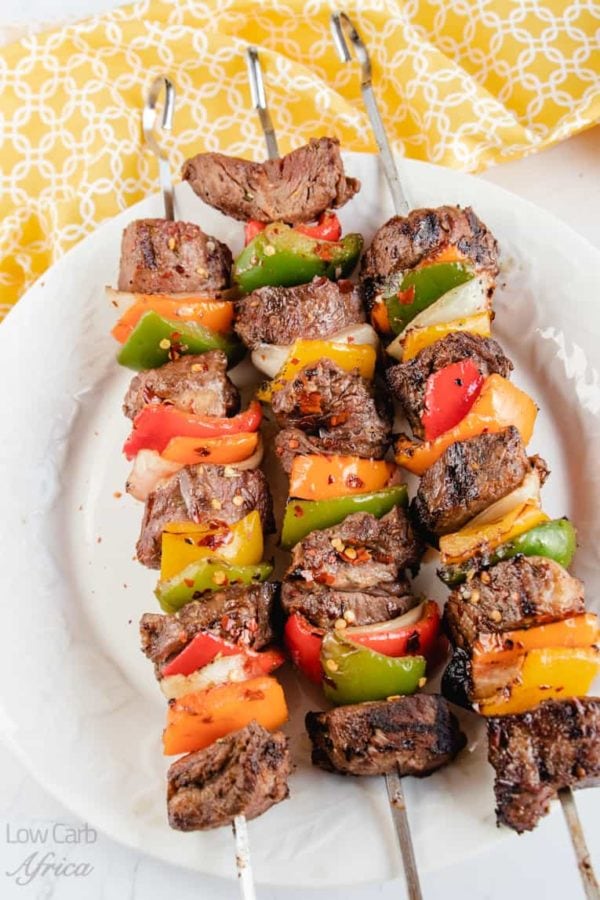
- Shish Kebabs from Low Carb Africa (pictured above) – This yummy recipe features not one but four bell peppers, red, orange, yellow, and green! This is a grilling recipe you’re gonna love.
- Grilled Vegetable Marinade with Lemon and Thyme from What a Girl Eats – Make a fantastic platter of grilled vegetables (bell peppers included!) with a lemony herb marinade to baste and dip!
5. STUFFED
Stuffed is definitely a popular method when it comes to cooking bell peppers. It’s great way to make them a star of the plate. The possibilities for what they’re stuffed with, and how they’re cooked, is extremely varied.
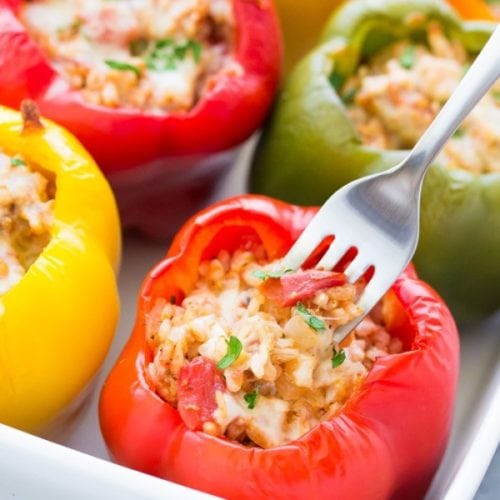
I could list dozens and dozens of stuffed bell pepper recipes. Heck do a whole post on just this! But instead, here are a few of my favorites from my fellow bloggers:
- Stuffed Peppers from Kristine’s Kitchen – this recipe is exactly what I think of when I want a classic stuffed pepper. Cheese, ground turkey, rice, all in a nice soft pepper.
- Breakfast Stuffed Peppers from Slow the Cook Down – These egg, cheese, and sausage stuffed peppers are just what you need to spice up boring breakfast.
- Spanish Stuffed Peppers from The Anthony Kitchen – A twist on a classic, with paprika, almonds, and manchego cheese, this recipe is full of spanish flavors you’ll enjoy.
- Stuffed Pasta Bell Peppers from Homemade Food Junkie – Cheese, pasta, all gooey in a sweet orange bell pepper, do I even need to say more?
6. STEWED
Finally, but not least flavorful, is a stewed preparation. A little less common perhaps, but worth your time. Stewing simply means to cooking slowly in liquid in an enclosed vessel, usually a pot or pan with a lid.
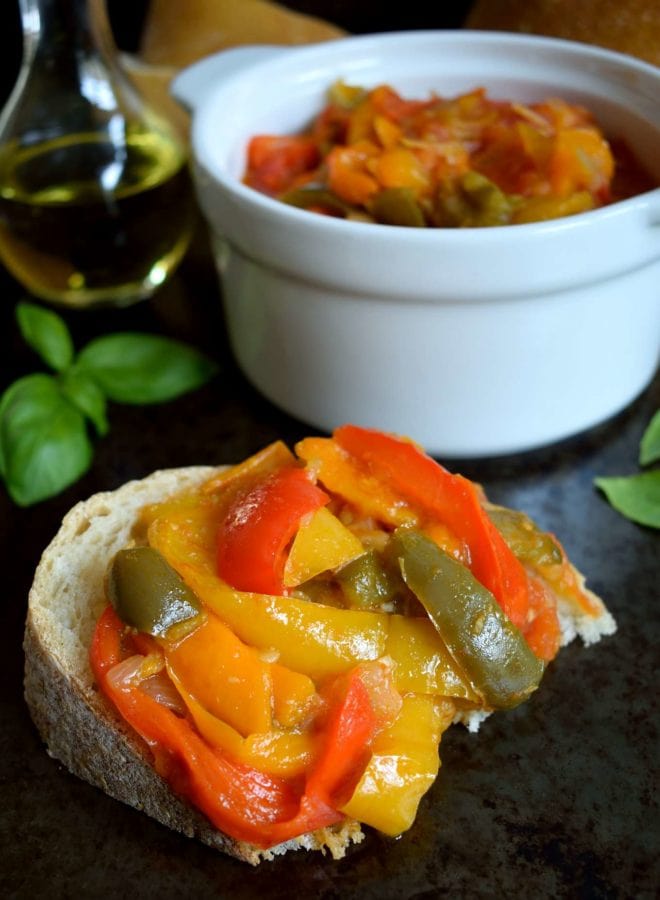
- Peperonata: Stewed Bell Peppers from Cilantro & Citronella – A classic stewed pepper dish that turns into a silky, sweet amazing dish that’s incredibly versatile.
I hope I’ve inspired you to explore the world of bell pepper recipes, while they’re still in peak season. Do you have your own favorites? I’d love to hear from you so feel free to comment below, or message me directly to chat!
Until next time, Happy Eating! (And don’t forget to PIN THIS POST for later!)
Nutrition information and cooking times are provided as a best estimate. Values may vary based upon ingredients and equipment.

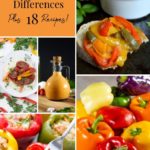
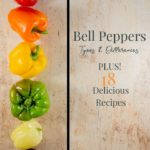
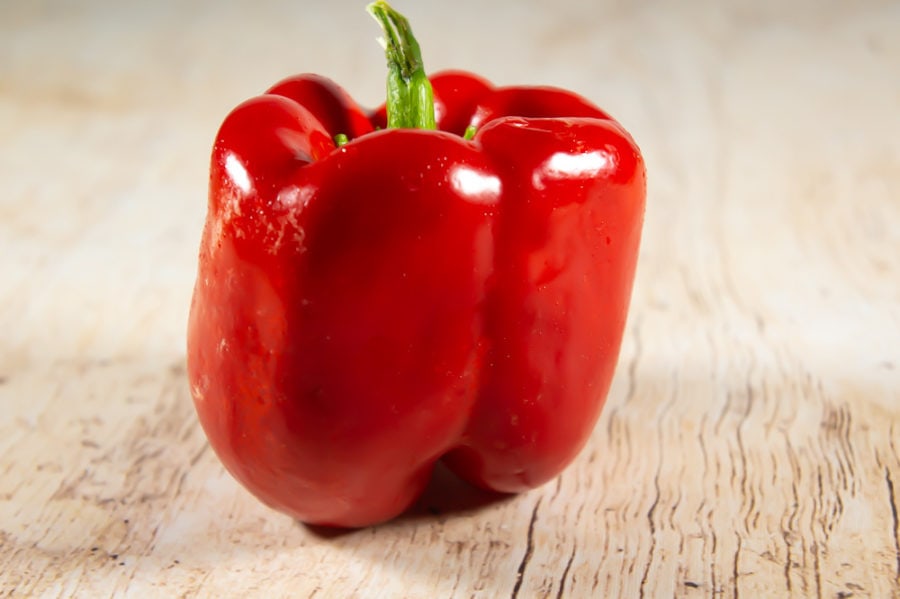
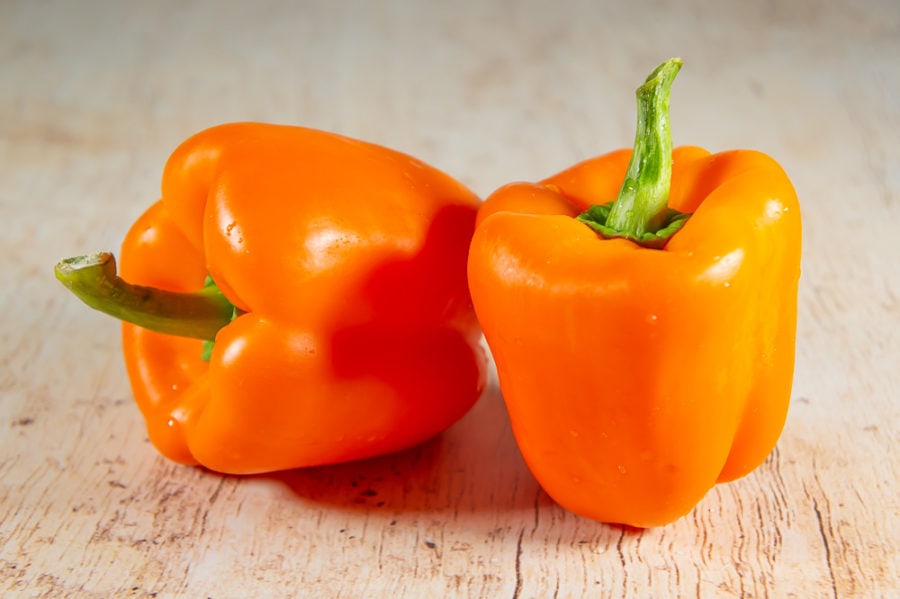
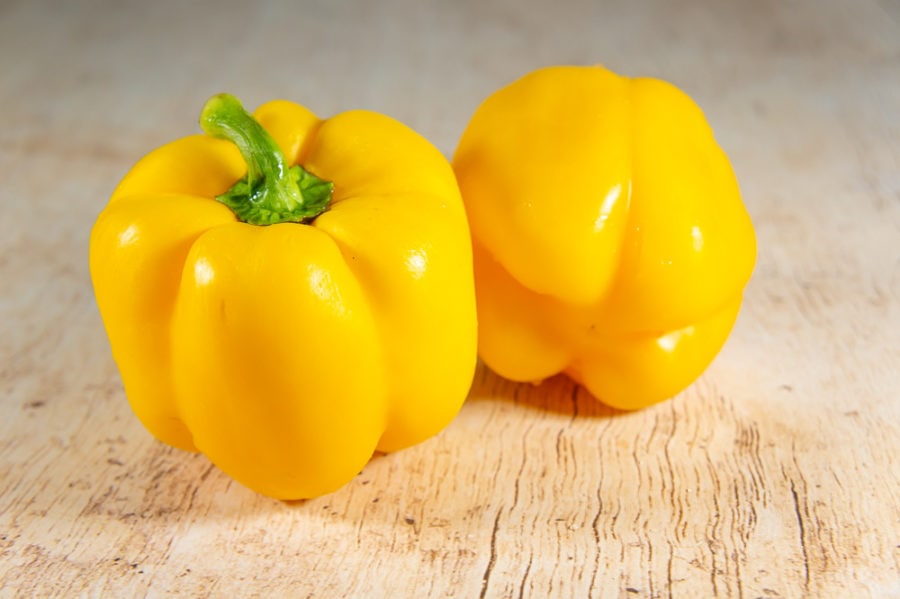
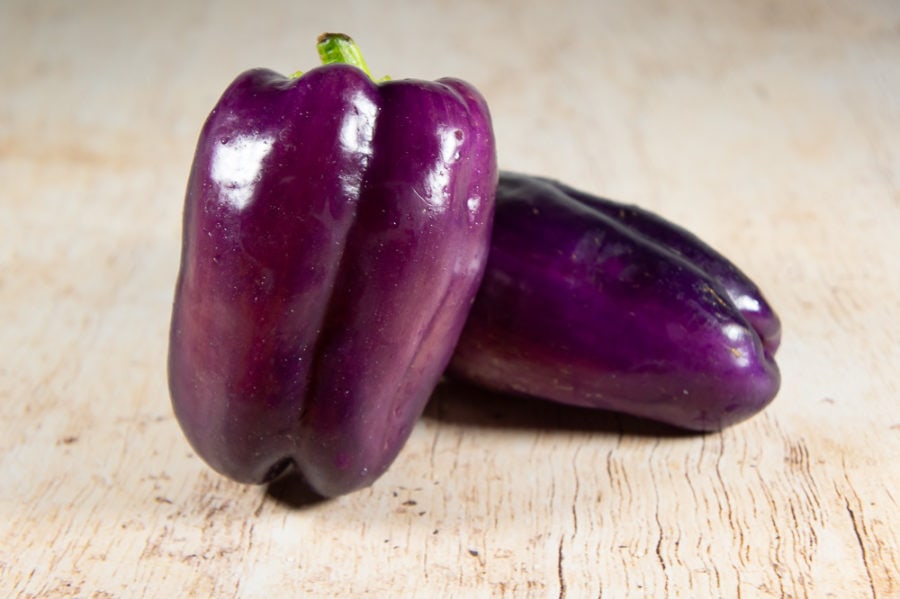
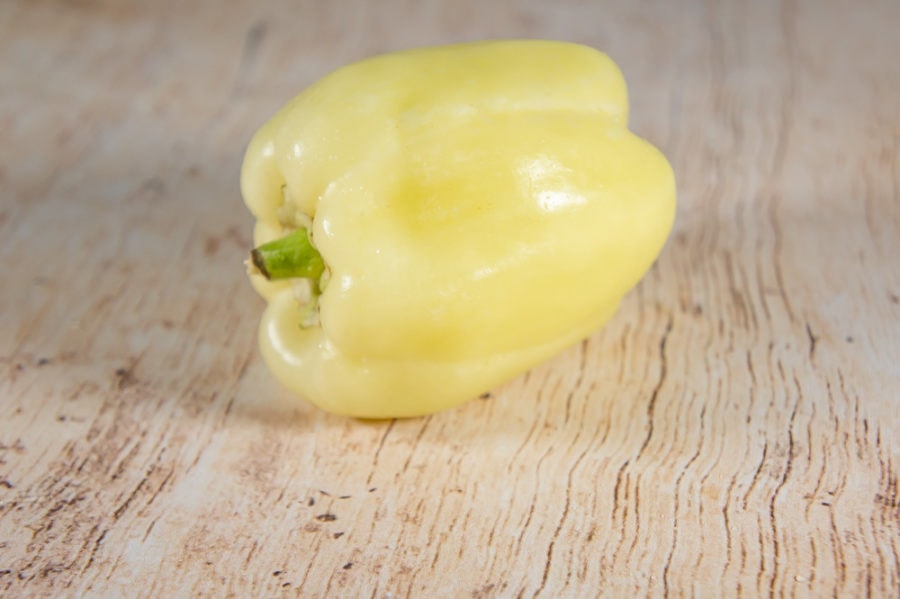
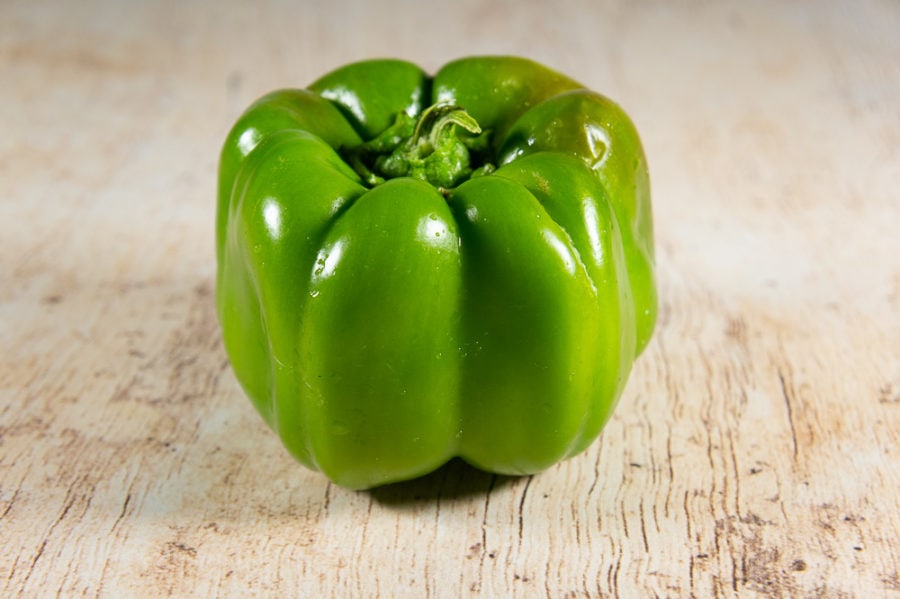
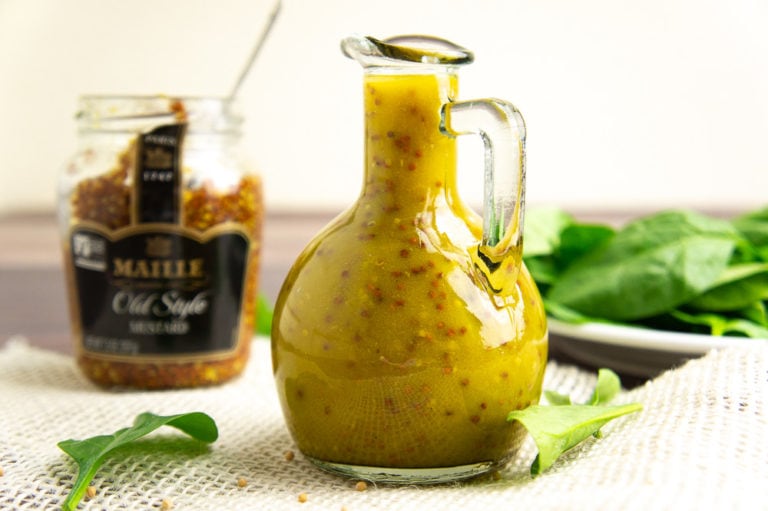
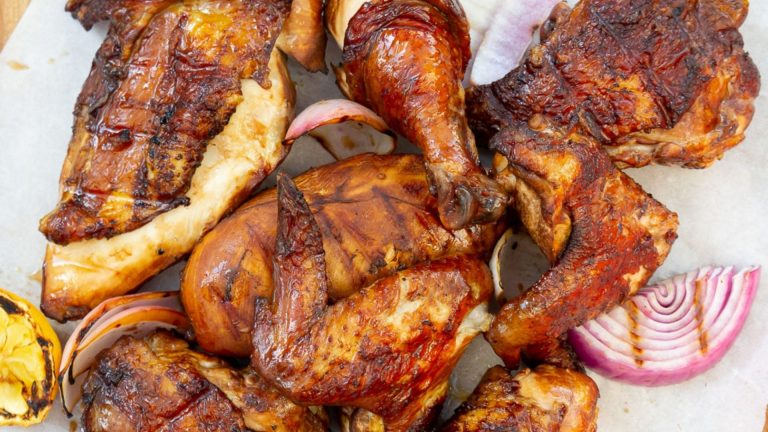

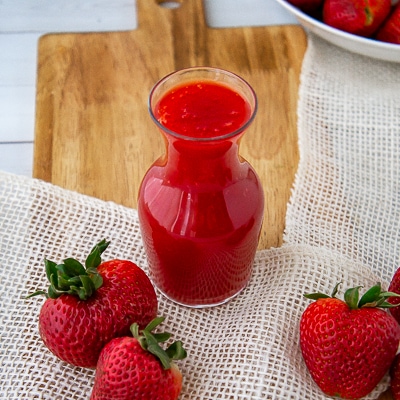
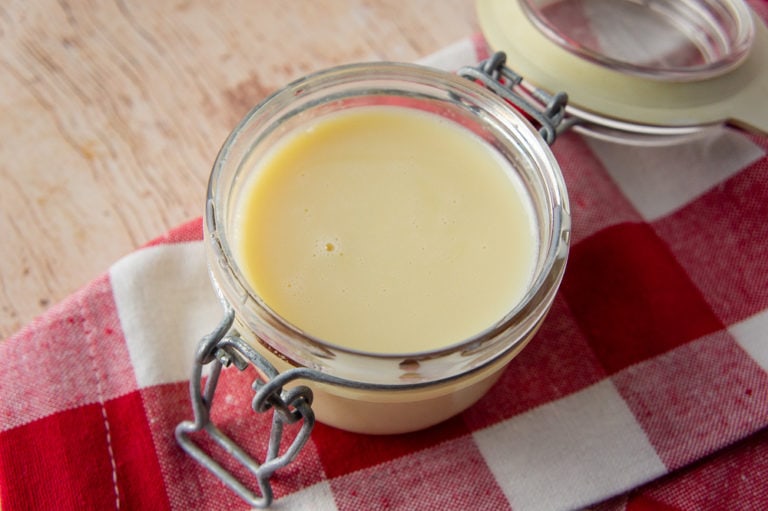
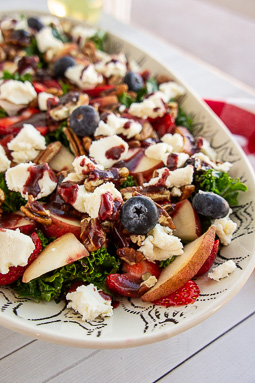
A great post indeed, informative and so useful. I love peppers and I do eat these every day. They are delicious, versatile and so good for us too.
I’m glad to hear it was useful to you, especially if you’re eating them everyday!
Wow, so much great information here! This was definitely informative, especially for bell pepper lovers. Pinning as a resource!
Thanks Amanda! I hope it’s useful to you in future cooking!
We love bell peppers (actually all peppers!) in my house. I honestly can’t decide if I like them raw or roasted better, but its rare that we make something savory and don’t add a few. This is a great overview of bell peppers. I particularly appreciated that you included the purple and white peppers to this as I see those so rarely at the market, but they are really fun to use in certain dishes that need a grassier, bitter bite.
Thanks Jenni! It seems purple and white are the dark horses among bell peppers, but I’m glad I could show them off to people here, they are so useful for exactly that purpose!
Ooooh, we never really see purple or white bell peppers in the UK. I’d love to try them.
I love raw peppers, they’re so sweet and delicious.
Katie xoxo
Raw is a fantastic way to enjoy them, I couldn’t agree more 🙂 I hope you get a chance to try white or purple someday!
This is brilliant – so informative! I always forget that stuffing peppers is an option. Will come back to this page every time I have leftover peppers!
I’m glad you found it informative Jacqui! I hope you find it useful in the future too 🙂
Bell peppers can easily make any dish stand out. They look great and taste even better! Really excited to explore these six different methods to cook bell peppers!
I hope you have a lot of fun exploring Mirlene! They really can make a dish, can’t they!
I am so happy I came across this! I love, love bell peppers. I live in a second world country where the peppers are absolutely the yellowest yellow, the reddest red, and the greenest green! Can wait to try these.
I can imagine how gorgeous your peppers must be! The vibrancy draws me in every time. I hope you have fun making some of these recipes!
Hahah. Maybe I just have no taste buds, but I have never really tasted a difference in the different colours. Maybe it would help if I bought them locally or at a farmers market
Haha Cathleen! 🙂 I can’t say for sure, but I do think they taste better, and more distinct from a local market!
I cook with bell peppers all the time, but this was still such an informative post. I’ve never even heard of purple peppers, let alone cook with them! Next time I post a recipe with peppers, I’ll be sure to link to your post!
Thank you Leanne! I’m so glad you found this informative 🙂 purple peppers are the harder find, but snag them if you ever get a chance!
I loved learning about the differences with the peppers! I also love the simple roasted pepper recipe! It sounds delicious!
I’m glad you enjoyed the read! Roasted peppers are super yummy, it’s true!
What a great read on bell peppers and the best ways to eat them. My favorite way to eat them is raw too!
They’re just so good like that! Crunchy, sweet, crisp, yum! Thanks for reading Kelly!
Wow, what a fantastic guide to bell peppers! I used to not like sauteed bell peppers, but it has grown on me. Bell peppers are just so versatile!
Thank you! It’s fascinating how our tastes can change isn’t it? I wasn’t a fan of any bell peppers until I was an adult!